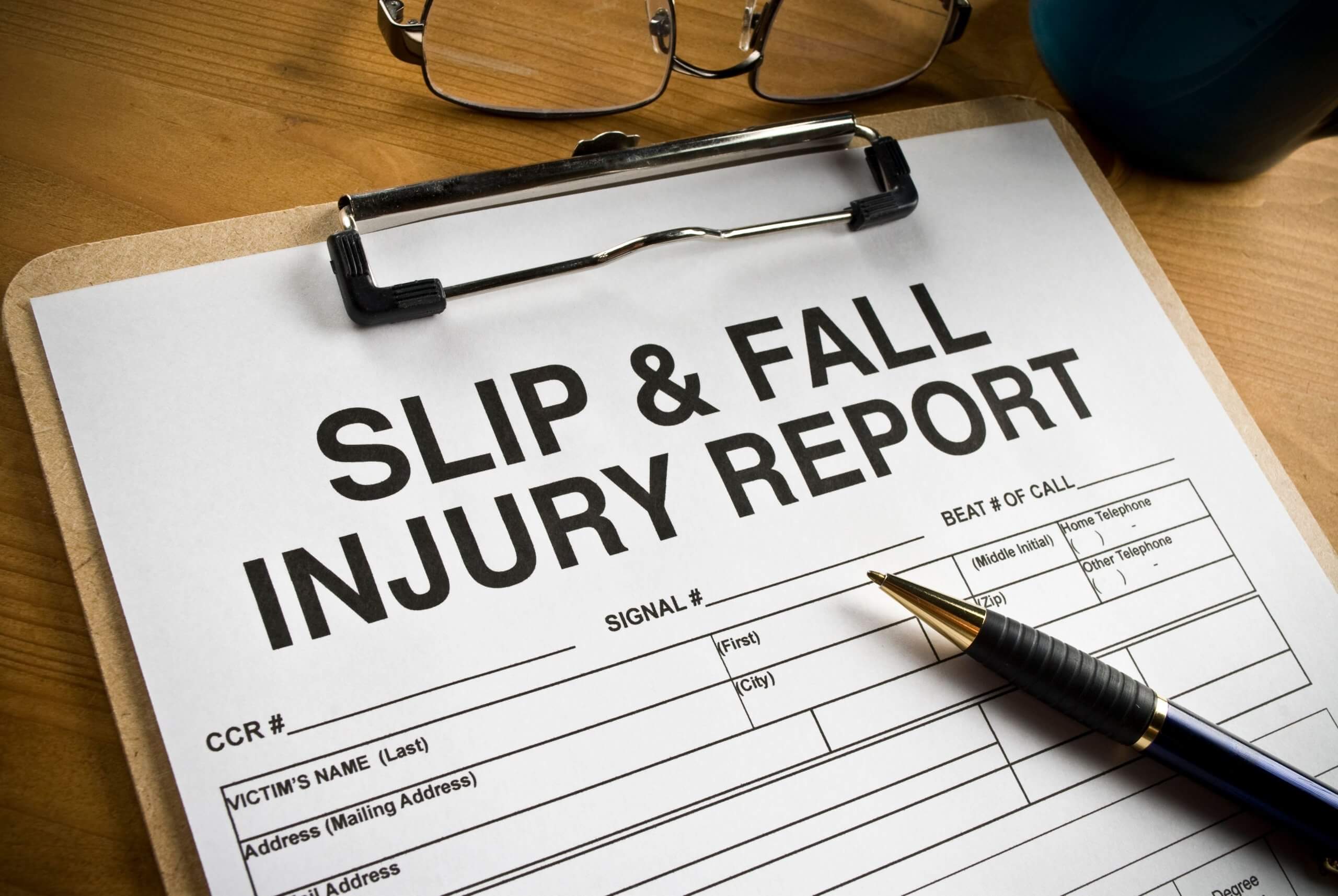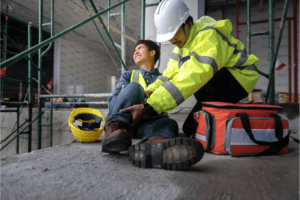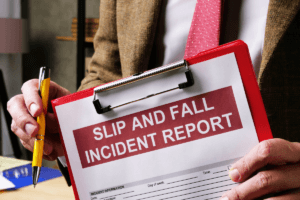What Happens After You Trip and Fall at Work?

Slip, trip, and fall accidents are the second-most common causes of workplace injuries and fatalities in California and most of the country. Despite rigid safety standards developed, implemented, and enforced by the Occupational Safety and Health Administration (OSHA), workers are still at risk of injury on construction worksites, shipyards, and marine terminals. Workplace slip, trip, and fall accidents involving unsafe walkways and working surfaces in California are second only to vehicle accidents on the job.
Common Slip, Trip, and Fall Accident Causes
People often slip and fall at work when they lose traction on floors that are slippery due to spilled liquids or other substances or after being freshly waxed. Other potential conditions that lead to slips, trips, or falls include:
- Unstable or uneven walking surfaces
- Irregular tiles
- Uneven carpeting
- Unsecured rugs or floor coverings
- Cables or cords running across floors
- Debris in walkways or on floors
- Unsecured ladders
- Missing or damaged railings along steps or elevated walkways
Regardless of the cause, slips, trips, and falls can lead to serious injuries. Workers can be left with serious injuries that affect their ability to return to work and lead fulfilling lives. By working with a skilled slip-and-fall attorney, these victims can seek compensation after being harmed by a negligent party.
Workplace Accident Statistics
Although most workers recover from their workplace accident injuries, others are not so fortunate. According to the U.S. Bureau of Labor Statistics (BLS), fatalities due to workplace slips, trips, and falls totaled 865, up 1.8% from the previous year. As many as 81% of these deaths were from falling to a lower level, such as from a walkway, ladder, or scaffolding.
Of the top ten most commonly cited violations by OSHA, four are closely related to slips, trips, and falls:
- Fall Protection, construction (29 CFR 1926.501)
- Hazard Communication (29 CFR 1910.1200)
- Ladders, construction (29 CFR 1926.1053)
- Fall Protection Training, construction (29 CFR 1926.503)
Fall protection, hazard communication, and ladder violations were numbers 1, 2, and 3 on the list, with fall protection training coming in at number 8. All of these contribute to a staggering number of injuries and deaths at California and U.S. workplaces every year. In fact, OSHA has been conducting a two-year campaign to address fall safety and tighten the rules for fall protection.
California Statistics
California workplaces have become somewhat safer, but the numbers still aren’t great. The BLS reports that slips, trips, and falls caused 16% of all workplace deaths, with most occurring in the transportation, warehousing, and construction industries.
A Slip-and-Fall Accident Can Be Life-Altering

Dealing with the physical and emotional damage from a slip, trip, or fall at work will take all your energy and time. You may be unable to call on family for assistance or be hospitalized while you recover. With these distractions, it can be challenging to find what it takes to collect evidence and file your claim.
Fighting for the full amount of your damages is difficult. If you are unable to handle your claim or lawsuit quickly enough, you could be left financially unstable with a lifetime of care expenses. If you can’t work, you could be overwhelmed trying to pay for housing and other bills. To avoid these burdens, it’s wise to schedule a free consultation with an experienced work injury attorney to discuss your legal options.
Preventing Slip, Trip, and Fall Accidents
The purpose of OSHA regulations and established industry standards and best practices is to ensure that workplaces are safe. Floor and walkway maintenance procedures are no exception. Employers can prevent the vast majority of slips, trips, and falls by establishing, implementing, and enforcing procedures and standards designed to keep the workplace clear and free of hazards.
In addition to good housekeeping practices and regular inspection and maintenance practices, it is also essential to implement proper lighting throughout the workplace, so that workers can easily see and avoid any potential walkway hazards. In addition, as much floor area as possible should have skid-resistant surfaces, and all sloping walkways, like ramps, should be equipped with handrails.
Many Parties Could Be at Fault for Your Slip, Trip, or Fall Accident at Work

If there is evidence that a company, including an employer, and / or a coworker directly caused an unsafe situation on a walkway or floor surface, they could be held liable. For example, if another employee spilled liquids or failed to secure electrical cords, causing you to trip and fall. If your lawyer can show the worker wasn’t trained to clean up the area – or another type of corporate negligence, the companies involved could be found at fault.
They may also be responsible if they knew or should have known about the problem and failed to alleviate the hazard. These situations can be very complex, especially since there are a number of avenues to getting compensation for your injuries. Some options include making a workers’ compensation claim with the employer or filing a personal injury lawsuit against other parties that may be responsible.
What To Do if You’re Injured In A Workplace Slip, Trip, or Fall Accident
When someone is injured in a slip, trip, or fall accident at work, the employer may be legally liable. Companies often have no-fault insurance programs to provide medical treatment and partial wages for injured employees, but your case may be more complicated. You can benefit from speaking with an experienced work injury lawyer to determine if third parties are at fault.
If you have been hurt in a slip, trip, or fall accident on the job, report the incident right away to your supervisor. You can then file a claim to secure benefits, although negotiating with the insurance providers can be frustrating and time-consuming. A work injury attorney can assist you with this process while also investigating the circumstances for any additional liability.
If necessary, your lawyer can file a lawsuit against any individuals or companies who contributed to your injury. For example, if an outside vendor failed to remove debris or spilled liquids after performing repairs, the person and their employer could be at fault. Your attorney will assess the situation and provide advice on how to move forward so you can make the best decision for your needs.
Potential Compensation in a Slip, Trip, or Fall Accident
If you file a workplace insurance claim, you should receive partial wages while you are recovering and payment for your medical bills. However, if a third party is at fault, you can and should seek additional damages from a personal injury lawsuit. These can include both economic and non-economic losses to fully compensate you for your injuries.
Economic damages include anything that has a price tag or receipt, such as:
- Medical expenses, including surgery, ICU, and ER costs
- Prescription medications
- Lost income
- Lost earning potential
- Home services (cooking, cleaning, maintenance)
- Loss of retirement savings and benefits
Non-economic losses are meant to address how your life has been impacted by your injuries. For example, if you are permanently disabled and cannot return to work, you may experience:
- Anxiety and depression
- Mental anguish
- Damage to your personal and professional reputations
- Loss of enjoyment of life
If you pass away from your injuries, your family could be eligible to file a wrongful death lawsuit against the at-fault parties. In California, the Code of Civil Procedure 377.60 allows certain individuals, such as the deceased’s personal representative, surviving spouse or domestic partner, and children to seek compensation for their loved one’s expenses prior to death. They can also file for damages that include funeral costs and other losses.
Statute of Limitations for Filing a Lawsuit in California
It’s important to act quickly if you believe someone is at fault for your workplace slip, trip, or fall injuries. You will likely need legal guidance to complete a request for insurance benefits from your employer’s program, and you may discover you have grounds for a lawsuit. The California statute of limitations for personal injury claims allows you to submit your case to the courts anytime up to two years from the date you were injured.
If you wait too long, valuable evidence could be lost or forgotten. Your lawyer will need as much time as you can provide to build the strongest case on your behalf. If the deadline passes, you will be unable to seek compensation through the courts.
Get Professional Representation for Your Workplace Slip, Trip, and Fall Claim
If you or someone you love has suffered a slip-and-fall in the workplace, contact the work injury lawyers at Curtis Legal Group. Rather than face these concerns alone, you can get compassionate and skilled legal representation from a team committed to your well-being. We work to hold at-fault parties responsible for their careless actions.
We have the experience and background necessary to help you protect your rights and obtain the compensation you deserve for a workplace injury. Contact us to schedule a free initial consultation today.
